Australiteuthidae
Australiteuthis aldrichi
Chung Cheng Lu and Richard E. YoungIntroduction
Australiteuthis aldrichi was described from numerous specimens collected from the inshore waters of Northern Australia. This is a dwarf species, the largest squid described was a mature female of 27.6 mm ML. The holotype is a mature male of 21.3 mm ML. The small squid has never been observed alive.
Brief diagnosis:
A myopsid squid ...
- with peculiar funnel locking-apparatus containing a boomerang-shaped groove.
- with fins separated from one-another and with posterior lobes.
- with dumbell-shaped photophore on ink sac.
Characteristics
- Funnel
- Funnel locking apparatus with subcircular shape and "bisected by a boomerang-shaped groove running anteroposteriorly. Anterior wing of the boomerang-shaped groove deep, with wide anterior end, groove deepens and becomes slightly narrower posteriorly to form deep, broad pit. Pit becomes a narrow and shallow groove posteriorly and turns medially forming posterior limb of the boomerang, posterior end of groove slightly widened." (Lu, 2005).
- Mantle component does not reach anterior mantle margin.
 Click on an image to view larger version & data in a new window
Click on an image to view larger version & data in a new window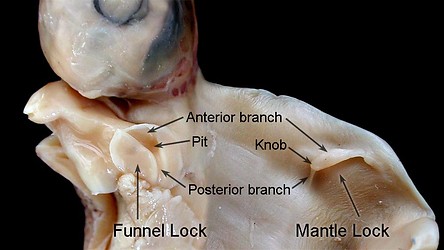

Figure. Frontal views of the funnel/mantle locking-apparatus of A. aldrichi, 17.3 mm ML, mature male, paratype. Top - Mantle cut open showing the funnel and mantle components of the locking-apparatus on the left side. Photograph from Lu (2005). The photograph also shows that there is no lateral adductor muscle connecting the funnel to the head and that there is no ventral secondary eyelid on the eye, a character state similar to that of loliginids but not sepiids and sepiolids. Bottom left - Funnel component. Bottom right - Mantle component. Bottom drawings were of the right locking apparatus but the illustration here has been flipped to coincide with the photograph. Drawings from Lu (2005).
- Funnel locking apparatus with subcircular shape and "bisected by a boomerang-shaped groove running anteroposteriorly. Anterior wing of the boomerang-shaped groove deep, with wide anterior end, groove deepens and becomes slightly narrower posteriorly to form deep, broad pit. Pit becomes a narrow and shallow groove posteriorly and turns medially forming posterior limb of the boomerang, posterior end of groove slightly widened." (Lu, 2005).
- Fins
- Fins large, round, separate (length 47-63% of ML, width 80-104% of ML); separation at posterior end inconspicuous.
- Fins with free anterior and posterior lobes.
- Fins large, round, separate (length 47-63% of ML, width 80-104% of ML); separation at posterior end inconspicuous.
- Photophores
- Large dumbell-shaped photophore present. The photophore appears to contain a large population of bacteria (Lu, 2005).
 Click on an image to view larger version & data in a new window
Click on an image to view larger version & data in a new window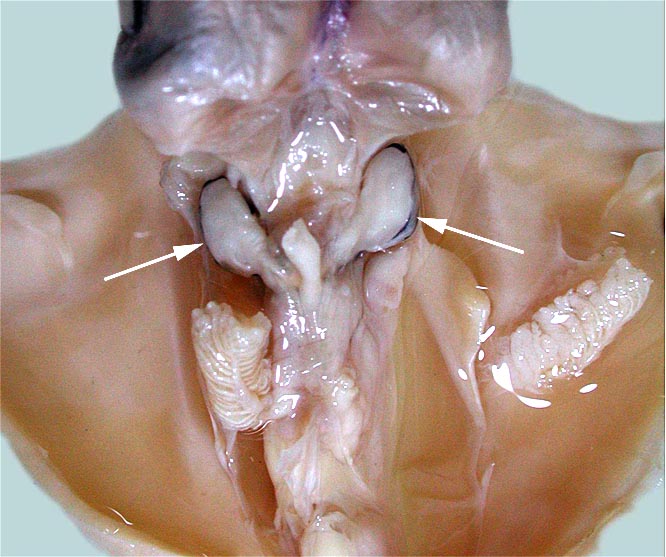
Figure. Photophore of A. aldirchi, 22.3 mm ML, mature male. A - Ventral view of the mantle cavity with some viscera removed showing the two lobes of the photophore (arrows) and rectum between the lobes. B -
 Click on an image to view larger version & data in a new window
Click on an image to view larger version & data in a new window
Figure. Histological section through one arm of the photophore. Note the inksac surrounding the photophore, the laminated structure (at the left) that presumably houses luminescent bacteria and the lens-like tissue (center top). At the far right is the rectum. Photograph from Lu (2005).
Comments
Distribution
Type locality: Joseph Bonaparte Gulf, Western Australia at 14°07.30S, 128°02.00'E. In addition to Joseph Bonaparte Gulf, squids have been collected from inshore waters near Darwin and Paupa New Giunea, which suggests a rather broad distribution in shallow waters of this general region.
References
Lu, C. C. 2005. A new family of myopsid squid from Australasian waters (Cephalopoda: Teuthida). P. 71-82. In: Chotiyaputta, C., E. M. C. Hatfield and C. C. Lu (editors). Cephalopod biology, recruitment and culture. International Cephalopod Symposium and Workshop, 17-21 Feb. 2003. Research Bulletin, Phyuket Marine Biological Center, No. 66, 365 pp.
Title Illustrations

About This Page

National Chung Hsing University Taiwan

University of Hawaii, Honolulu, HI, USA
Page copyright © 2019 and
All Rights Reserved.
- First online 20 September 2005
- Content changed 20 August 2019
Citing this page:
Lu, Chung Cheng and Richard E. Young. 2019. Australiteuthidae . Australiteuthis aldrichi . Version 20 August 2019. http://tolweb.org/Australiteuthis_aldrichi/52671/2019.08.20 in The Tree of Life Web Project, http://tolweb.org/





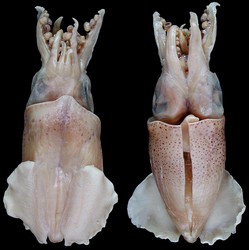
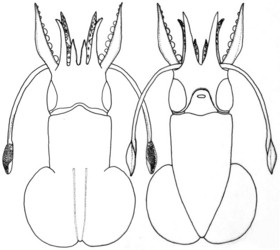
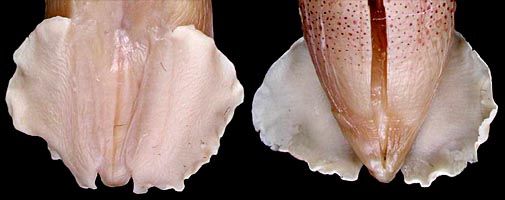




 Go to quick links
Go to quick search
Go to navigation for this section of the ToL site
Go to detailed links for the ToL site
Go to quick links
Go to quick search
Go to navigation for this section of the ToL site
Go to detailed links for the ToL site